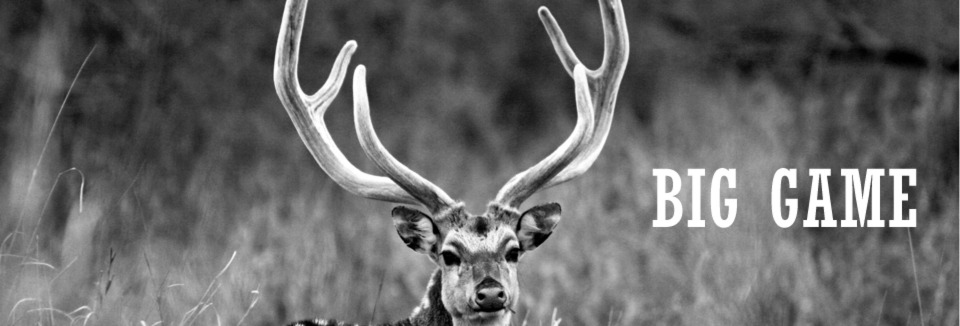
Hawaii Bowhunting
 Hawaii Bowhunting Game Species
Hawaii Bowhunting Game Species
Before the Polynesians arrived, Hawai‘i had no hoofed animals. The first Polynesian voyagers brought small pigs that were kept as livestock, not released into the forest or hunted as later animals were.
During the First Contact era in which Captain Cook arrived in the islands, it was common for ships’ crews to release domestic animals on the islands they visited, to multiply and provide a food source for future visits. Beginning in 1778 Cook, and subsequent visitors, brought goats, sheep, cattle, and European swine to Hawaii, All these animals thrived and began to permanently alter the island landscape, as grazing animals do all over the world.
Around 1900, faced with massive watershed damage by feral mammals, the Hawai‘i Territorial Board of Agriculture and Forestry initiated an animal control program. It included shooting, poisoning, bounties, and fencing a system of Forest Reserves. In about 50 years, 170,000 feral pigs were removed from the forests statewide, along with tens of thousands of goats and other hoofed animals.
Beginning in the 1950s, additional game species were introduced. DOFAW’s forerunner, the Hawaii Division of Fish and Game, introduced Mouflon to Kaua’i, Hawai’i, and Lana’i. Axis deer, previously limited to Moloka’i, were introduced to Maui, Lana’i, and O’ahu. With statehood in 1959, HDFG took over responsibility for free-roaming hoofed animals from the Board of Agriculture and Forestry. HDFG ended the policy of reducing animal populations to protect the land and water and instituted a policy of sustained yield, with bag limits and hunting seasons.
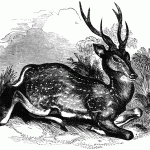 The Hawaiian Axis Deer known as Axis, Chital, or Spotted Deer is a native of India. The first Hawaiian Axis Deer were imported in 1868 to the island of Moloka’i as a gift to King Kamehameha from the government of Hong Kong. Populations have multiplied and spread, today there are excellent hunting opportunities for these deer on the Islands of Molokai, Lanai and Maui.
The Hawaiian Axis Deer known as Axis, Chital, or Spotted Deer is a native of India. The first Hawaiian Axis Deer were imported in 1868 to the island of Moloka’i as a gift to King Kamehameha from the government of Hong Kong. Populations have multiplied and spread, today there are excellent hunting opportunities for these deer on the Islands of Molokai, Lanai and Maui.
The Axis Deer is often considered the most beautiful cervid. Both male and female have striking reddish-brown coats marked by white spots arranged in undisciplined rows along their sides. They have a black dorsal stripe and white bib on their neck, white inner legs, stomach, and under-tail. Bucks have darker facial markings with a more pronounced “scowling” expression the older they get.
Hawaiian Axis Bucks generally lose their velvet in the spring and come into rut during the months of June and July. However, they can be in hard horn any time of the year. Hawaiian trophy bucks range from 30 to 36 inches. Axis have a typical antler structure of three points on each side consisting of a main beam, one secondary point halfway up the beam, and a brow tine. Four points on a side are relatively uncommon here in Hawaii.
In the Hawaiian Islands Axis deer inhabit upland forests to dry, arid grasslands and can be found from sea level to over 4000 feet in elevation. Hawaii Axis Deer are super-alert at all times and can be extremely wary. They are a true test for any archer by spot and stalk where average shots can be 30-40 yards, often through thick cover. Axis deer are also vulnerable to treestands and ground blinds where terain permits. Axis deer venison is definitely one of our favorites and compares favorably with Rocky Mountain Elk or Red Deer.
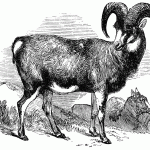 Mouflon Sheep were first introduced to the Islands of Lanai and Hawaii (the Big Island) in the 1960s. On the Island of Lanai Sheep can be found along the dry kiawe and grassland coast of the North and West portion of the island. On the Big Island both feral Mouflon (interbred with domestic sheep) and pure-bred Mouflon, can be found on the upper slopes of Mauna Loa volcano, Hawaii Volcanoes National Park. The Hawaiian Mouflon (Ovis aries orientalis) is a subspecies group of the wild sheep Ovis aries. Populations of Ovis aries Mouflon is thought to be one of the two ancestors for all modern domestic sheep breeds.
Mouflon Sheep were first introduced to the Islands of Lanai and Hawaii (the Big Island) in the 1960s. On the Island of Lanai Sheep can be found along the dry kiawe and grassland coast of the North and West portion of the island. On the Big Island both feral Mouflon (interbred with domestic sheep) and pure-bred Mouflon, can be found on the upper slopes of Mauna Loa volcano, Hawaii Volcanoes National Park. The Hawaiian Mouflon (Ovis aries orientalis) is a subspecies group of the wild sheep Ovis aries. Populations of Ovis aries Mouflon is thought to be one of the two ancestors for all modern domestic sheep breeds.
Mouflon rams weigh about 115 pounds with ewes somewhat lighter. Both sexes may be recognized by their generally tan to brownish body color. Rams often display a distinct dark chest and white saddle patch. The underparts and inner side of the limbs are white; the rump is white with a short black tail. The horns of the rams are characterized by one wide curl. Ewes are usually hornless.
Mouflon are a terrific bowhunting challenge and can be very difficult to stalk due to their eyesight, alertness and tendency to seek out dense brush when disturbed. A full-curl ram is a spectacular trophy with its multicolored coat, wide spreading horns and black neck mane. Trophy Hawaiian Mouflon range between 28 and 32 inches. The meat is delicious and can be prepared in a variety of ways.
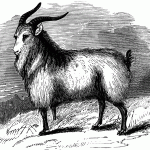 Spanish Goats were introduced to Hawaiian Islands in 1778 by Captain James Cook. Goats can be found on all the major Hawaiian Islands with the exception of Lanai from sea level to over 9000 feet. They prefer rocky slopes and open lava fields in drier areas.
Spanish Goats were introduced to Hawaiian Islands in 1778 by Captain James Cook. Goats can be found on all the major Hawaiian Islands with the exception of Lanai from sea level to over 9000 feet. They prefer rocky slopes and open lava fields in drier areas.
Goats forage on grasses and other vegetation and are particularly damaging to Hawaii’s native plants. In the 1960’s, Hawaii Volcanoes National Park fenced small areas to prevent goats from foraging and discovered native plants previously unseen came back and thrived in their absence. Since then, concentrated efforts to eradicate goats from the park include barrier fencing and the hunting and dispatching of animals.
Hawaiian Goats are relatively small animals with mature billies weighing up to 100 pounds, nannies range between 40 and 60 pounds. Shot placement is key, Hawaiian goats vital areas are much further forward than other game animals. Always wait for a quartering away shots, and put your arrow high and tight tight behind the shoulder.
Goats are generally found in herds and will station sentinels to keep watch. Be warned, if you are busted they will alert the rest of the group with a warning call: a quick snort. Hawaiian Goats rely primarily on their eyes, their noses and hearing are not great. Keep behind cover and you can move relativly quickly into range.
 Vancouver Bull Spaniards introduced the first cattle to the New World via Veracruz, Mexico in 1521. Captain George Vancouver loaded descendents of these animals at the Spanish Mission in Monterey, California when he set off across the Pacific, intending to use them as food and gifts. Vancouver presented this gift of “Longhorns” to Kamehameha I in 1793. The first cows and bulls given to the Hawaiians fared poorly, either falling ill and dying, or quickly being killed and eaten. When Vancouver landed additional cattle on his next voyage at Kealakekua Bay in 1794, he strongly encouraged Kamehameha to place a 10-year kapu (prohibition) on them to allow the herd to grow.
Vancouver Bull Spaniards introduced the first cattle to the New World via Veracruz, Mexico in 1521. Captain George Vancouver loaded descendents of these animals at the Spanish Mission in Monterey, California when he set off across the Pacific, intending to use them as food and gifts. Vancouver presented this gift of “Longhorns” to Kamehameha I in 1793. The first cows and bulls given to the Hawaiians fared poorly, either falling ill and dying, or quickly being killed and eaten. When Vancouver landed additional cattle on his next voyage at Kealakekua Bay in 1794, he strongly encouraged Kamehameha to place a 10-year kapu (prohibition) on them to allow the herd to grow.
Grow they did, into a huge problem. The kapu was not lifted until 1830 – cattle flourished and turned into a dangerous nuisance. By 1846 over 25,000 wild cattle roamed the Big Island and an additional 10,000 semi-domesticated cattle lived alongside humans. A wild bull or cow could weigh 1,200 to 1,500 pounds and had a six-foot horn spread. Vast herds destroyed crops, ate the thatching on houses, and attacked and sometimes killed people.
By the time of Kamehameha III’s reign (1824-1854), something had to be done. After the kapu was lifted in 1830, the hunting of wild cattle was encouraged. The King hired bullock hunters from overseas to help in the effort. Many of these were former convicts from Botany Bay in Australia. Hunting sometimes ended in inadvertent tragedy. In 1834, the trampled dead body of Scottish botanist David Douglas – for whom the Douglas Fir is named – was discovered in a bullock pit on Mauna Kea. Though suspicious head wounds and a quantity of missing cash also implied murder.
The progeny of these original “Vancouver Bulls” are still a sought-after game annimal today. They are extremely wary and can be difficult to locate. They are most often found in heavy cover and make for excellent spot and stalk opportunities. Mature bulls can reach the “bigger than you want to know” size and can be extremely dangerous.
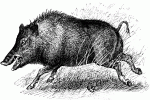 Polynesian Wild Boar (Sus scrofa) The Hawaiian Pua’a is a descendant of the small Asiatic domestic pigs introduced by Polynesians in the early colonization period (400 AD) and the larger European domestic pigs first introduced by Captain James Cook beginning in 1778.
Polynesian Wild Boar (Sus scrofa) The Hawaiian Pua’a is a descendant of the small Asiatic domestic pigs introduced by Polynesians in the early colonization period (400 AD) and the larger European domestic pigs first introduced by Captain James Cook beginning in 1778.
Found on all main islands except Lana’i. Widely distributed, but found mostly in wet forests and open mountain pastures. Forages for vegetation and worms by rooting in the ground.
Pua’a are responsible for great ecological damage by constant rooting and trampling native vegetation and spreading invasive plant species (such as strawberry guava and banana poka) over large distances. The Pua’a also create water pools in depressions from their rooting and in cavities left behind after they’ve eaten the starchy interior of knocked down Tree Ferns. These water pools are an ideal breeding ground for mosquitoes that transmit avian malaria. Native forest bird habitat and numbers have been significantly reduced as a result of the feral pig’s introduction.
We try to do our part by culling the herd as often as possible. Pigs are found in forest openings or on the fringes of agricultural areas. They are a great spot-and-stalk challenge as their sense of smell and hearing are excellent. Fortunately for us they don’t see so well which allows bowhunters to close the distance with the right conditions. Big boars sport a heavy bone-like plate that shields their vital area- good shot placement and a tough broadhead are key for quick, humane harvest.
Hawaiian wild boar can grow to over 200 pounds with trophy Pua’a sporting teeth over 4 inches long. They are great table fare whether prepared in a traditional Hawaiian Imu (cooking pit), smoked, as sausage, or our favorite, Kalua Pig and Cabbage.


